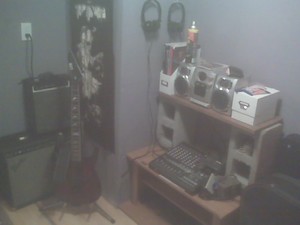Jack
Picking Technique
Dec 18, 2011

Picking Technique
By
Jack Aikens
Many guitarists spend countless hours, weeks, months, even years developing their left hand chasing a perfect legato technique and overlook the most important aspect to their potential progress; right hand picking technique. You can race all over the fretboard hammering and pulling notes at 250bpm and you will still lack rythmic pulse and the articulations that make your phrasing come alive if you fail to build rythmic dexterity and precision in your picking hand. In essence you will be "finger flopping" up and down scales and it will be noticeable. There is no way to hide inadequate picking technique and there is no shortcut, despite what many "methods" advertise, to acheive it. The only way to acheive the type of proficiency to play on level with guitarists such as Jimi Hendrix, Randy Rhoads, Steve Vai, and Yngwie Malmsteen is to build picking techniqe by starting out slow, memorizing your pattern, keeping both hands relaxed, and working with a strict meter set by a metronome or drum machine.
Everything should be worked out slowly at first. Whether its a scale, chord, or arpegiated phrase you have to be sure of your pattern and each and every pick stroke. You have to walk before you can run. Hold the pick relaxed in your right hand perpendicular to the string you are going to start on. With a flick of your wrist push the tip of the pick through the string and come directly back through if alternate picking is your goal, which if you are working out a scale it probably should be, making sure to not let the pick travel farther than necessary in either direction past the string. Only use the very tip of the pick. Sometimes it helps to choke up on the pick or hold it so that just the tip is sticking out past the edge of your thumb.
To anchor or not to anchor is a matter of personal choice and feel. Some people find that anchoring their pinky to the body of the guitar helps with accuracy. I find it more efficient to use the blade of my picking hand as my anchor to judge distance since I have to use it to help keep my strings quiet to begin with.
When working with a metronome or a drum machine you are going to want to be able to hear the "down beats" so you should slow it down till you can count "one, two, three, four" with the beat. These "down beats" are going to coincide with your picking attack on the way down and should sync up with the exact instant your pick sounds the note on its way down through the string. This creates the rythmic pulse in the music you are playing since in 99% of all guitarist their downstroke is going to be stronger and more develped than the up stroke of their picking technique anyway. The "up beat" that happens on the way back up is now a no brainer. It may take some work at first till you can "feel" the new tempo of striking notes exactly twice as fast as you were picking all down strokes but it shouldn't take very long to get the hang of it.
Now you will want to begin upping the tempo of the drum machine or metronome. Do this by increments of 8 beats per minute once you are comfortable playing your given pattern at the current tempo. For example someone works out an alternate picking scalar sequence at 94bpm, once he/she is comfortable with that tempo, maybe there is a goal to play the sequence from each fret up and down the neck, once this is done he/she can adjust the metronome/drum machine up 8bpm to 102bpm. Once this is repeated at 102bpm, move on to 110 bpm. Never wait to get it perfect because you never will. You will however, get a little better each day if you consistently work toward a goal such as to run a scalar sequence in thirds up and down the neck at 255bpm. The first day when you hit 255bpm you many not be anywhere near on time, but if you know this and each day work to a faster and faster tempo you will be at your target
Share
Post comment
Like
Merry Christmas!
Dec 11, 2011

Yesterday I uploaded the entire Christmas CD I recorded for my daughter's Headstart Class a few years back called "Nativity On Six Strings." Enjoy!
Share
Post comment
Like